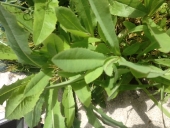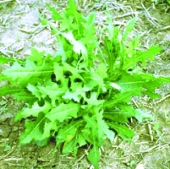
 2
2




 2
2




 1
1




 7
7









 2
2




 4
4




 2
2

















Zach Muller wrote:When the stalks form and it flowers is the traditional time to collect the latex i do believe. My plants are usually so full of latex at that point that it actually weeps out just from touching the leaves. Cut the top of the plant and collect the white material that flows out and you can continue making cuts down the stalk, collecting as it flows.
You can eat the greens fresh during its rosette phase and there will be effects, although i would consider it more of a food and less of a special medicine at that time.
Is your plant lactuca virosa?
 8
8




Ione Shirley wrote:
Can you please tell me a simple way to fix this. Do I boil it? Dry it? I'm confused. I need SIMPLE step by step
instructions. I've gathered several stalls but now I don't know what to do with it. I need it for back pain (2 major surgeries) and can't take opiods. Tia
 3
3




 1
1




Invasive plants are Earth's way of insisting we notice her medicines. Stephen Herrod Buhner
Everyone learns what works by learning what doesn't work. Stephen Herrod Buhner




Anne Miller wrote:Joy, thank you for sharing that information on pain relief.
Thanks everyone for sharing.
 3
3




 2
2




"I was born / I was born to sing for you ♪ / I didn't have a choice but to lift you up / And sing whatever song you wanted me to ♫
I give you back my voice / From the womb my first cry, it was a joyful noise..."








 1
1




Our inability to change everything should not stop us from changing what we can.
 5
5




 2
2








Dwayne Oxford wrote:Here in Eastern W. TN(Holladay) it's near time, Moon is increasing, drawing sap from roots.
I simply strip leaves from stalk, chop stems with coarsest blade of Cuisinart processor, fill gallon jar about 1/2 full, fill with Organic Apple Cider Vinegar, let sit for couple three months, shaking up occasionally.
I draw ounce out with baster, put in glass and add 4-5 oz. water and drink.
Works similarly to 500 mg. Tylenol for me.
I hope that I die before my dreams do.




Life is not about the destination but the journey. Joy is not found in finishing an activity but in doing it.




Sincerely,
Ralph




Ralph Kettell wrote:Hi Moira,
It is none of the above. I to was confused until I saw some this year in the woods. Wild Lettuce is like a very tall dandelion. There leaves look like the shape of dandelion but it has an upright growth. The ones I saw were between one and two feet tall and not yet starting to bloom. They were growing in the woods and supposedly this is an extremely common weed.
I hope this helps.
Sincerely,
Ralph




 4
4




Ralph said " Wild Lettuce is like a very tall dandelion. There leaves look like the shape of dandelion but it has an upright growth. The ones I saw were between one and two feet tall and not yet starting to bloom.

Invasive plants are Earth's way of insisting we notice her medicines. Stephen Herrod Buhner
Everyone learns what works by learning what doesn't work. Stephen Herrod Buhner
 3
3








I'm only 65! That's not to old to learn to be a permie, right?








Life is not about the destination but the journey. Joy is not found in finishing an activity but in doing it.




 1
1




 2
2




 1
1












Zach Muller wrote:
Also as fred said the Milky sap is very bitter, and will make your mouth numb if eaten fresh. But it is kind of an aquired taste like other bitter things so it is worth a try.
Mandrake...takes on and holds the influence
of the devil more than other herbs because of its similarity
to a human. Whence, also, a person’s desires, whether good
or evil, are stirred up through it...
-Hildegard of Bingen, Physica

|
This is my favorite tiny ad:
Freaky Cheap Heat - 2 hour movie - HD streaming
https://permies.com/wiki/238453/Freaky-Cheap-Heat-hour-movie
|





